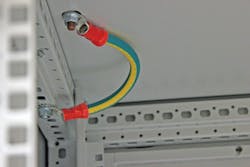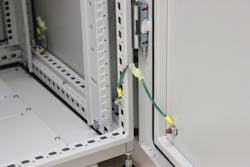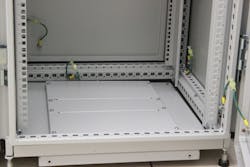With cabling being deployed in industrial plants and other edge environments, grounding and bonding equipment remain necessities.
The rise of the Internet of Things and every environment being a connected environment, means structured cabling systems are being installed in facilities and structures in which they previously were not. While significant attention is being paid to the physical characteristics of a cabling system that can enable it to perform as expected in these new environments, it remains true that cabling systems must be bonded to a building’s grounding (earthing) system.
We recently conversed with Sam Rodriguez, senior product manager for cabinet and thermal-management solutions with Chatsworth Products Inc. (CPI). Rodriguez, a Registered Communications Distribution Designer (RCDD) with more than 20 years’ experience in telecommunications, answered several questions about the deployment of telecommunications systems, cabling, and cabinets/enclosures in environments like industrial plants, as opposed to data centers. Our conversation emphasized the bonding/grounding aspects of these deployments.
When deploying enclosures, it is important to select grounding and bonding wires that meet the application’s required amperage. Bond the top, side panels and the doors to the enclosure frame.
CI&M: What are some of the primary differences between cabling deployments in a data center versus otherenvironments?
SR: One is access. In a data center that’s under tight control, very few people have access to the cabinets. But when a cabinet is in an industrial environment, on an open floor, the cabinet and its contents are accessible to many people and as a result could be at greater risk. If an enclosure is mounted outside, there’s the potential for even more people to come into contact with it in some way. It could be placed in an area prone to water or puddling. Also with respect to grounding, in a data center, the grounding network is a core part of the system. Everybody sees it; everybody thinks about it. When a company places a cabinet on the factory floor and the IT department is responsible for it, it is just as important as the grounding system in a data center, and it must be planned for. The system owner must build a simple route to run the wire back to the grid, but these [grounding/bonding] systems are not always top-of-mind in environments outside of data centers.
CI&M: Because of differences in physical characteristics, some enclosures are generally considered “IT” enclosures and others are considered “industrial” enclosures. Do these differences affect grounding and bonding?
SR: In some cases the purchaser will have to specify that the enclosure gets a grounding kit. Typically, with the purchase of an IT enclosure, a grounding kit is included. However, many times with an industrial enclosure, a grounding kit is not included standard. Also, the gauge you use will depend on the voltage that’s being put into the enclosure. Whoever is responsible for preparing the panel will have to decide the load and the amperage, and choose the correct grounding kit accordingly.
Also, once you’re outside of a data center, you can be dealing with different mounting schemes. DIN rail mounting is popular in industrial applications. Those using rails must ensure the rails are bonded to the infrastructure. It’s typical for enclosures to include a bus system; many times fixtures on wall studs are mounted directly to panels. Sometimes that will include a copper busbar that the end-user can use to attach multiple pieces of equipment. The busbar also can be inside the enclosure, which is similar to the typical setup in an equipment room. These are all things to consider—ahead of time—when you’re selecting an enclosure.
CI&M: Given the importance of grounding and bonding, do suppliers offer a wide portfolio of products to suit uniqueapplications?
SR: Yes, most do. And the applications can be unique. Some customers will specify grounding points on the enclosure itself. Wiring kits can include 6-gauge wire all the way down to 2-gauge wire if the system is using more amperage.
We also see a single-point mounting method employed. Often, whether a single-point method or a two-point method is used will depend on whether or not an IT professional is responsible. IT installs typically specify a two-point connection. The single-point method is not as common, but is acceptable.
CI&M: Anything else that’s particularly worthwhile for specifiers and users of these systems to know?
SR: One thing that’s important to think about—and enclosure manufacturers already should be addressing this—is properly dealing with an enclosure that includes a very large panel and a gasket.
When a gasket is present, it prevents metal-to-metal contact. You need to bond anything that has a high probability of being electrified, so in a unibody-construction enclosure, the entire box is bonded at once.
With a modular-construction enclosure, however, some of the seals can act as insulators. That’s just another reason to ensure the enclosure is properly bonded, with wires going from the frame into the skin.
TIA grounding-standard addendum addresses multi-tenant buildings
The Telecommunications Industry Association’s ANSI/TIA-607-C Telecommunications Bonding and Grounding (Earthing) for Customer Premises standard was published in November 2015. It includes several modifications from the “B” version of the 607 standard. For example, the C standard includes requirements for a structure’s electrical grounding electrode system, and the additional telecommunications grounding electrode system design and testing requirements. Those specifications had been spelled out in the first addendum to ANSI/TIA-607-B. The C standard also adds requirements for a telecommunications bonding and grounding system when structural metal is used as the telecommunications bonding backbone. That detail originally was spelled out in the second addendum to 607-B. After the ANSI/TIA-607-C standard was published in late 2015, the TIA’s TR-42 committee developed an addendum to it. In January 2017, the TIA published ANSI/TIA-607-C-1 Bonding in Multi-tenant Buildings. The addendum covers bonding and grounding requirements in buildings that serve more than one tenant. It describes a common bonding infrastructure for telecommunications equipment providing shared services and the connection of individual tenant bonding infrastructures to the common bonding when present, or the equipment ground when a common bonding infrastructure is not present.



